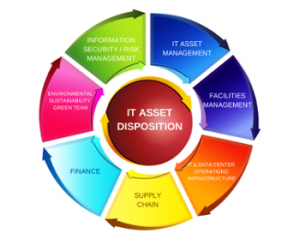 With increased media, shareholder and customer attention on data breaches and environmental impacts from corporations of all types, IT asset retirement is becoming a key corporate service. Many companies are looking to create corporate-wide standards and manage the process and costs for the disposal process. One of the challenges is making sure you have covered all aspects of the retirement and disposal process for your organization. To do that, you need to include stakeholders and decision makers from a number of different disciplines.
With increased media, shareholder and customer attention on data breaches and environmental impacts from corporations of all types, IT asset retirement is becoming a key corporate service. Many companies are looking to create corporate-wide standards and manage the process and costs for the disposal process. One of the challenges is making sure you have covered all aspects of the retirement and disposal process for your organization. To do that, you need to include stakeholders and decision makers from a number of different disciplines.
We’ve reviewed the key stakeholders and their concerns in a previous post. Here are those with some additional insights about the stakeholders and their concerns:
1. Information Security/Risk Management.
ITAD concerns:
- Compliance: HIPPA/HITECH, SOX, PCI, Gramm-Leach, etc.
- State and federal regulations related to all PII (Personally Identifiable Information)
- Solid State Drive (SSD) data security at retirement
- Corporate data security and risk policies.
2. IT Asset Management
ITAD concerns:
- Software and operating system license compliance.
- Minimal costs.
- Maximum investment recovery.
- Lack of resources for handling, tracking assets.
- Integration of disposition data in asset management systems.
3. Facilities Management.
ITAD concerns:
- Space for secure storage.
- Time, resources, material to do packing, audits.
4. IT and Data Center Operations/Infrastructure
ITAD concerns:
- Refresh and end-of-life decision-making to ensure maximum value and return on investment (ROI) for capital budget.
- Resource availability for hard drive data destruction.
- Quality assurance process; ability to audit.
5. Supply Chain
ITAD concerns:
- Ensure vendors meet corporate requirements.
- Minimal costs.
- Simplify
6. Finance
ITAD concerns:
- Inventory accuracy by asset, status on books.
- Software and operating system license compliance.
- Minimal cost.
- Maximum investment recovery.
7. Environmental/Sustainability/Green Team
ITAD concerns:
- Compliance with all environmental regulations and corporate sustainability goals.
- Report details for corporate environmental/sustainability reporting.
The program approach to IT asset disposition
By identifying stakeholders and their concerns, you’re on the road to creating a Next Gen Enterprise ITAD program, one with specific roles and procedures for every link in the chain, recognizing the differences among the various departments and locations in your organization and tailoring the process to fit their needs and capabilities. This approach makes it as easy as possible for team members to do ITAD right, every time, for every location. By implementing and following a programmatic approach to ITAD, your organization will also be able to better manage costs and maximize returns, with an enterprise-wide pricing and service structure from your ITAD vendor.
A guide to ITAD self-assessment
Need help getting started? Beginning by identifying stakeholders and taking stock of your current program, Lifespan’s guide, “How to Perform an IT Asset Disposition Plan Self-Assessment,” is an easy-to-use tool that will help you create a roadmap for a new, comprehensive ITAD program.


